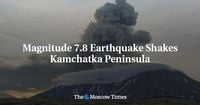In the early hours of September 19, 2025, residents of Russia’s far eastern Kamchatka Peninsula were jolted awake by a powerful earthquake that rattled homes, sent furniture skidding across floors, and briefly triggered tsunami warnings across the Pacific Rim. According to the U.S. Geological Survey, the quake registered a magnitude of 7.8 and struck at a shallow depth of just 10 kilometers (about six miles) beneath the sea, roughly 128 kilometers (80 miles) east of the regional capital, Petropavlovsk-Kamchatsky.
Videos that quickly surfaced on Russian social media captured the intensity of the tremor: chandeliers swayed violently, dishes clattered in cupboards, and parked cars rocked in the streets as the earth heaved beneath them. For many in Kamchatka, this was a frighteningly familiar scenario. The region, after all, sits squarely on the Pacific Ring of Fire—an arc of seismic and volcanic activity that circles the Pacific Ocean and is notorious for producing some of the world’s most powerful earthquakes.
The local branch of Russia’s state geophysical service, which monitors seismic activity in the area, put the quake’s magnitude slightly lower at 7.4. Regardless of the exact figure, the shaking was strong enough to prompt immediate concern. The U.S. Pacific Tsunami Warning Center responded quickly, issuing a warning of possible hazardous waves for nearby coastlines. For several tense hours, residents and officials alike braced for the possibility of a tsunami, recalling the devastation wrought by similar events in the recent past. But as the morning wore on, the threat receded. The warning was lifted, and relief spread across the region.
Regional Governor Vladimir Solodov took to Telegram to address the public, seeking to calm nerves and provide reassurance. "This morning is once again testing the resilience of Kamchatka residents," he wrote. "There are currently no reports of damage. I ask everyone to remain calm." His message was echoed by local authorities, who, after initial inspections, confirmed that there were no immediate reports of injuries or structural damage. Still, the sense of unease lingered, as aftershocks—at least five, according to the Russian geophysical service—continued to ripple through the area.
This earthquake was not an isolated incident. In fact, it was just the latest in a series of significant seismic events to strike Kamchatka since July 2025. That month, an even more powerful 8.8-magnitude earthquake struck off the coast, unleashing a tsunami that swept part of a nearby coastal village into the sea and prompted tsunami warnings as far away as Japan and the western United States. The memory of that disaster remains fresh for many locals, and the string of aftershocks since then has kept nerves frayed and emergency services on high alert.
Kamchatka’s reputation as one of the world’s most seismically active regions is well earned. Its location at the meeting point of several tectonic plates makes it a hotspot for earthquakes and volcanic eruptions. The peninsula is dotted with volcanoes—some of them among the most active on the planet—and its residents are no strangers to the rumble of the earth beneath their feet. Yet, as Friday’s quake demonstrated, even those accustomed to such events can be caught off guard by their power and unpredictability.
According to the U.S. Geological Survey, the quake’s shallow depth likely contributed to the strong shaking felt across the region. Shallow earthquakes tend to cause more intense surface shaking than deeper ones, making them particularly dangerous when they occur near populated areas or critical infrastructure. Fortunately, Petropavlovsk-Kamchatsky, though relatively close to the epicenter, appears to have escaped serious harm this time.
For many residents, the initial moments after the quake were filled with uncertainty. With memories of July’s tsunami still fresh, the prospect of another wave sent some scrambling for higher ground. Local authorities, however, moved quickly to assess the situation and communicate with the public. The swift lifting of the tsunami warning by the U.S. Pacific Tsunami Warning Center brought a measure of relief, but officials urged continued vigilance as aftershocks rattled the region.
"We are monitoring the situation closely and will provide updates as necessary," Governor Solodov assured residents. His call for calm was heeded by most, though the anxiety was palpable. In a place where the earth never seems to rest for long, resilience is not just a virtue but a necessity.
Seismologists and emergency officials in Kamchatka are well versed in disaster preparedness. Drills and public education campaigns are a regular feature of life on the peninsula, and most households keep emergency kits stocked and evacuation plans at the ready. Still, the frequency and magnitude of recent earthquakes have tested even the most seasoned residents.
Friday’s quake is a stark reminder of the ongoing risks faced by those living in seismically active regions. While there were no immediate reports of damage or casualties this time, the potential for future disasters remains ever-present. The events of July, when a tsunami swept away part of a coastal village, serve as a sobering warning of what can happen when nature’s forces are unleashed at full strength.
Experts say that continued vigilance and investment in early warning systems are crucial for minimizing the impact of future earthquakes and tsunamis. In recent years, advances in seismic monitoring and communication technology have improved the ability of authorities to warn residents and coordinate emergency responses. But as Friday’s events show, the unpredictability of earthquakes means that there is always an element of uncertainty.
For now, Kamchatka’s residents are breathing a sigh of relief. The ground has settled, the tsunami threat has passed, and life is returning to normal—at least until the next tremor. As Governor Solodov put it, the resilience of the people is being tested once again. But in a land shaped by fire and ice, where the earth’s power is always close at hand, resilience is something Kamchatka has in abundance.
With no reported damage and the tsunami warning lifted, the people of Kamchatka are reminded once more of their region’s volatile beauty—and their own capacity to weather whatever the earth throws their way.
